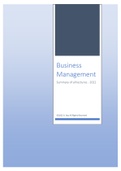Summary
Summary Business Management (BM) - contains both exams
- Course
- Institution
This document entails a detailed summary of the Business Management course of everything you need to know for the exams. It is divided into two parts (for the first and second exams) and contains many examples and explanations of phenomena that I initially thought were complicated to understand.
[Show more]



